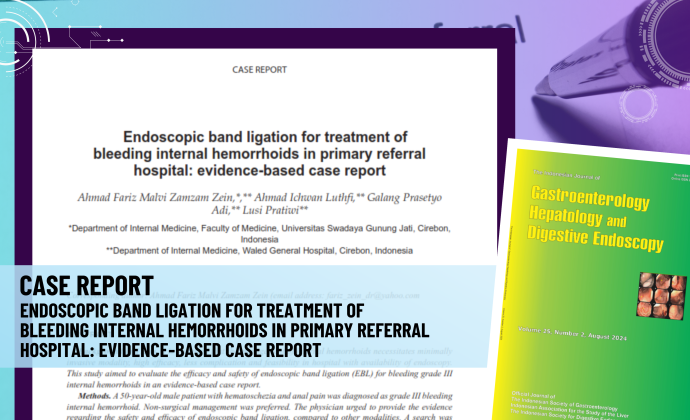
Endoscopic Band Ligation for Treatment of Bleeding Internal Hemorrhoids in Primary Referral Hospital: Evidence-Based Case Report
The case report by Dr. Ahmad Fariz Malvi Zamzam Zein, SpPD, MM, FINASIM, FACP, Dr. Ahmad Ichwan Luthfi, Dr. Galang Prasetyo Adi, and Dr. Lusi Pratiwi has been published in The Indonesian Journal of Gastroenterology, Hepatology, and Digestive Endoscopy Vol. 25, No. 2 (2) under the title “Endoscopic Band Ligation for Treatment of Bleeding Internal Hemorrhoids in Primary Referral Hospital: Evidence-Based Case Report.”
This study explains the effectiveness and safety of endoscopic ligation in controlling bleeding and reducing the degree of hemorrhoids in patients with grade III bleeding internal hemorrhoids.
Abstract
Background and Aim: The preferred management of internal hemorrhoids requires a minimally invasive modality, high efficacy, fewer complications, and feasibility in hospitals with endoscopy availability. This study aimed to evaluate the efficacy and safety of endoscopic band ligation (EBL) for bleeding grade III internal hemorrhoids in an evidence-based case report.
Methods: A 50-year-old male patient with hematochezia and anal pain was diagnosed with grade III bleeding internal hemorrhoid. Non-surgical management was preferred. The physician sought to provide evidence regarding the safety and efficacy of endoscopic band ligation compared to other modalities. A search was conducted on PubMed and Cochrane databases based on clinical queries, using the keywords “endoscopic band ligation AND internal hemorrhoids.” The inclusion criteria were meta-analysis, systematic review, and randomized clinical trial, and the studies had to be written in English. A critical appraisal was performed for validity, importance, and applicability.
Results: Of 18 studies, only 2 met the criteria. Compared to bipolar electrocoagulation (BPEC), EBL had a significantly higher success rate in controlling bleeding and reducing the grade of hemorrhoids. In comparison with band ligation with a rigid proctoscope (BL-RP), EBL was associated with a higher success rate, fewer treatment sessions, and earlier symptom control. Mild complications and symptomatic recurrence were comparable among EBL, BPEC, and BL-RP.
Conclusion: Endoscopic band ligation is effective and safe for bleeding grade III internal hemorrhoids. It is a feasible procedure in a primary referral hospital.
Keywords: bleeding internal hemorrhoids, efficacy, endoscopic band ligation, safety
For the complete research article, please visit the following link:
The INA-JGHE Vol. 25, No. 2 (2024)




 Users Today : 225
Users Today : 225 Total views : 2138025
Total views : 2138025 Who's Online : 3
Who's Online : 3